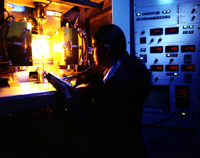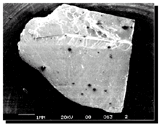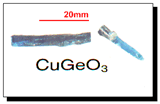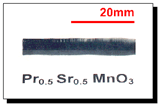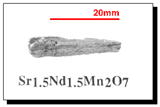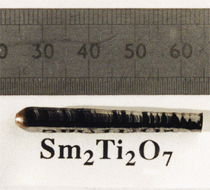Single Crystal Growth @ Warwick
Single Crystal Growth at Warwick
|
The crystal growth programme at Warwick was established in 1985. Initially our efforts were focused on the production of superconducting materials. A wide range of growth techniques were employed, the most important of which was the use of an infra red image furnace. We were the first research group in the UK to use a furnace of this kind. Single crystals of high Tc oxides and related materials were produced for our own EPSRC funded superconductivity research programme and were made available to collaborators within the UK and abroad. |
|
|
|
Geetha Balakrishnan programming the two mirror IR image furnace. A schematic of this furnace is shown below left. |
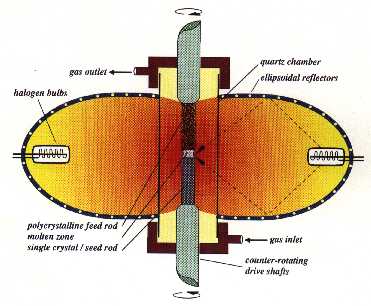 |
||
|
|
|
|
|
Schematic of our NEC two-mirror IR image furnace. |
|
We currently have three operational image furnaces. In 1999 we acquired a Crystal Systems Incorporated halogen image furnace. This furnace, which has four mirrors, allows us to work either in a vacuum (or low pressures of gas) or at pressures of up to 10 bar. In 2001 we purchased a four mirror Xenon arc image furnace. This system is capable of reaching 2800 °C. In 2007, we obtained funding for our third system, a Canon Machinery SC1-MD11020 infra red image furnace.
We have widened the use of our IR furnaces to grow a variety of materials and thus exploit the capabilities of these machines to the full. The range of materials grown includes superconductors, frustrated and low-dimensional magnets, and refractory borides and carbides. These crystals are an essential component of all of our own EPSRC supported research projects. Many single crystal samples have also been grown to meet the requirements of scientists working at other institutions. A summary of the crystal growth work carried out over the last few years is given below. For details of publications resulting from our EPSRC funded crystal growth work please refer to the publications page of this web site.
For more details of all the crystal growth facilities available within the group click here or visit the Group and User Facilities page of this site after you have finished reading this page.
Superconducting Materials
|
The preparation of single crystals of superconducting materials was, and continues to be, an important component of our crystal growth programme. One of the first materials we attempted to prepare in single crystal form using the IR furnace was the high Tc oxide Bi2Sr2CaCu2O8 (BSCCO). This activity proved to be very successful and these crystals were used in a wide variety of experimental programmes both here and abroad. |
|
|
| A single crystal of the superconductor Bi2Sr2CaCu2O8. | ||
We have also prepared single crystals of many other superconductors using more conventional techniques. These include the ternary stannides of the type Yb3Rh4Sn13, Ca3Rh4Sn13 with Sn flux, RNi2B2C using Ni-B flux and the CDW superconductor NbSe2 by vapour transport. As well as being used in our own investigations of superconducting materials, many collaborative projects with other institutions have been successfully established to study superconducting crystals.
CuGeO3 and Spin-Peierls Compounds
|
|
CuGeO3 is an inorganic system with a spin-Peierls transition at 14 K and is a good example of a Cu2+ low dimensional system with interesting magnetic and structural properties. We have produced many single crystals of CuGeO3, and its doped derivatives, Cu1-x(Zn/Ni)xGeO3, with 0.012 < x < 0.069 in the IR furnace using a floating zone technique. The crystals grew along the c axis and were faceted, typically 3 × 3 × 40 mm3. The size and quality of the crystals enabled extensive neutron scattering studies to be carried out to investigate the spin-Peierls and Neel phases. |
|
| Crystal of CuGeO3 grown by the floating zone method (growth speed 2-3 mm/h in air). |
Low Dimensional Compounds
Manganese Perovskites
|
The floating zone method is an ideal way of growing single crystals of these oxides. Single crystals of the n = infinity compound can be grown as large boules for most compositions. |
|
|
|
A large number of crystals have been successfully grown for R1-xAxMnO3, where R = La, Pr or Nd and A is either Sr or Ca for x < 0.8. These crystals have been used in elastic and inelastic neutron diffraction studies. |
Crystal of Pr0.5Sr0.5MnO3 grown by the floating zone method (growth speed 6-8 mm/h in air). This compound has an antiferromagnetic transition at 140 K coincident with the onset of charge ordering of the Mn3+- Mn4+ sublattice. Crystals of ~1 cc can be grown for most compositions containing La, Pr, Nd and Sr. |
Interesting results have also been obtained by performing experiments on these crystals in applied magnetic fields and/or under pressure. There has also been a tremendous demand for these crystals from other research groups throughout the world.
|
The double layer manganites have also been grown for several compositions R1+xSr/Ca2-xMn2O7. The processed boules are long and faceted and may be cleaved along the growth direction to produce single crystal platelets. The crystals also exhibit a whole range of magnetic transitions and are being investigated both in-house and using a variety of neutron and x-ray scattering instruments based at central facilities. |
|
|
|
| R1+xSr2-xMn2O7 crystals grown at a rate of 6-8 mm/h in air. These crystals cleave easily along the growth axis to reveal shiny faces. These two layer manganese perovskites are very similar in structure to the high Tc materials and have anisotropic transport and magnetic properties. | |||
Frustrated Magnets
|
|
This is especially true of the pyrochlores where previously only small volume flux grown crystals of these materials were available. We have been able to grow large high quality crystals of a whole family of pyrochlores, namely, R2Ti2O7 where R = rare earth. Crystals of several cms length can be grown with ease in either air, O2 or Ar depending on the requirements. This is the first time large crystals of these compounds have been grown and has clearly demonstrated the versatility of the IR furnace/floating zone method of crystal growth. |
|
| High quality single crystal of the Sm pyrochlore grown in air. |
Gadolinium Gallium Garnet (GGG)
Single Crystal Growth @ Warwick
The single crystal growth programme at Warwick has benefited from significant financial support from both the University and the EPSRC for equipment and staff. These include grants from 2007- 2010 (EP/E011802/1Link opens in a new window) 2011-2014 (EP/I0072100/1Link opens in a new window), 2015 - 2018 (EP/M028771/1Link opens in a new window).
The publications resulting from these grant periods are listed separately on the Publications SectionLink opens in a new window of this website.
Current and Future Work
If you would like to know more about the single crystal growth programme based here at Warwick, or you would like details of the crystals we have grown that may be available for collaborative projects, please do not hesitate to contact us.
Write toProfessor Geetha Balakrishnan |
|
Contact DetailsOffice: P236
Telephone: +44 (0)2476573879 |

